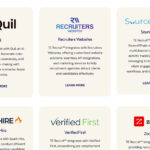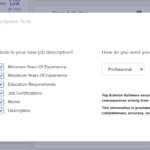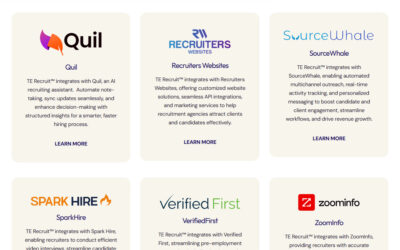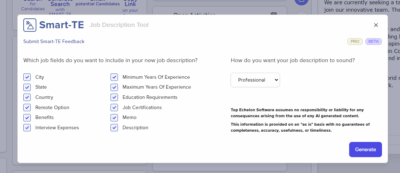Onboarding new recruiters is a delicate balancing act. On the one hand, you want to onboard them as quickly as possible so they can start contributing independently and efficiently. On the other hand, you must ensure they have ample time to acclimate to their new environment, develop necessary skills, and become integrated into the company culture. Rushing through onboarding results in underprepared employees, whereas an overly lengthy process can delay the return on investment (ROI) for the new hire. Success in onboarding requires a balance of training, hands-on experience, time, and thoughtful pressure.
In this article from Top Echelon Recruiting Software, we will explore the essential components of a robust onboarding process for recruiters, offering a comprehensive roadmap that leads to higher retention rates, better productivity, and more satisfied employees. The key is to take it slow, set clear expectations, monitor progress, and offer support. This approach, though it requires investment, results in new hires becoming effective and integrated team members much faster.
The Foundations of Onboarding
A structured onboarding process rests on four essential pillars, often referred to as the “Four C’s” of onboarding: Compliance, Clarification, Culture, and Connection. Developed by Tanya N. Bauer, an expert in team management, these four elements provide the foundation for effective onboarding. Companies that address all four aspects tend to have higher employee retention and satisfaction rates than those that only focus on one or two.
Compliance
Compliance refers to the legal and administrative aspects of getting a new employee started. This includes filling out necessary paperwork, such as tax forms, direct deposit authorizations, and healthcare documentation. Additionally, this stage ensures that new hires are equipped with the tools they need to do their job—be it a company laptop, access to necessary software, or login credentials for communication platforms.
Although this part of onboarding may seem dry, it’s crucial. Delays in compliance-related tasks can disrupt an employee’s early experience, leading to frustration and a sense of inefficiency. Efficiently completing compliance tasks gives new hires the foundation they need to focus on higher-level responsibilities without administrative roadblocks.
Clarification
Clarification involves making sure that new hires understand the scope of their role. What are their primary responsibilities? What are your expectations for their performance in the first 30, 60, and 90 days? What benchmarks will be used to measure their success?
This phase of onboarding is where misunderstandings are clarified, and expectations are aligned. Many new hires falter because they were unclear about what their roles truly entailed. A well-structured clarification process ensures that your new recruiter knows their specific duties and how their work fits into the broader goals of the organization.
Culture
Culture is one of the more intangible but critical elements of onboarding. Company culture consists of the norms, values, and behaviors that dictate how things are done in your organization. While some aspects of culture may be documented—such as dress codes, communication protocols, or performance evaluation criteria—others are more informal and harder to define.
For recruiters, understanding the culture can be a game-changer. Knowing how to approach sensitive matters, how to interact with various team members, and understanding office hierarchies will help them navigate daily tasks with ease. Furthermore, fostering a culture of inclusivity can help new hires feel more integrated and connected to their teams, reducing feelings of isolation or uncertainty.
Connection
Connection refers to how well a new hire integrates into the social fabric of the company. Building relationships with colleagues, clients, and other key stakeholders is essential for long-term success. For recruiters, networking is not just a skill but a critical aspect of the job.
The connection phase also involves relationship-building outside of the company, particularly with clients and candidates. Successful onboarding will facilitate these early interactions, helping new hires create meaningful connections that can lead to long-term professional relationships.
Formal vs. Informal Onboarding: Choosing the Right Path
One of the major decisions to make when onboarding new recruiters is whether to take a formal or informal approach. Both have their merits, but the choice largely depends on the structure and culture of your organization.
Formal Onboarding
Formal onboarding is a structured process with clear milestones and objectives. It typically includes a set agenda for the first few months, which outlines what the new hire will be doing, learning, and accomplishing. The advantage of this approach is its clarity. There’s little guesswork involved, which reduces stress for both the recruiter and the manager. Additionally, formal onboarding has been proven to dramatically improve employee retention and satisfaction rates.
A structured process ensures that critical components such as compliance, clarification, culture, and connection are covered in depth. It provides a clear timeline for progress and allows managers to monitor development more closely. For roles that require technical skills or deep company knowledge, such as recruitment, formal onboarding is often the best choice.
Informal Onboarding
Informal onboarding is much more relaxed. In this approach, new hires are typically expected to learn by doing. The process may follow a “sink or swim” mentality, leaving employees to figure out the ins and outs of the job with little guidance. While this can sometimes accelerate the learning process, it comes with significant risks. New hires may struggle without adequate support, leading to confusion, frustration, and poor performance.
While informal onboarding works well in fast-paced or highly dynamic environments, it is not ideal for recruitment. The role of a recruiter involves relationship-building, compliance with legal hiring practices, and an understanding of specific market needs—all areas where clarity and support are essential.
Tips for an Effective Formal Onboarding Process
1. Orientation: A Critical First Step
Orientation is the first impression a new hire gets of your company, and it sets the tone for their entire experience. The goal is to handle compliance tasks while also introducing them to the company culture and values.
During orientation, focus on both the logistical and social aspects of onboarding. Process all the paperwork upfront so that the new recruiter can move forward without distractions. Then, introduce them to their team and key stakeholders. Encourage discussions about office culture—where people typically gather for lunch, social events, and unwritten rules of the office. These small gestures can go a long way in helping a new hire feel comfortable.
In today’s digital age, orientation is not just about face-to-face interactions. Utilize technology to give new hires access to training videos, industry webinars, and online resources that provide a broader context for their work. A mix of traditional and digital orientation strategies can create a more engaging experience.
2. Developing a Structured Schedule for Onboarding
For a new employee, especially in a role as critical as recruitment, a structured schedule acts as a roadmap. A well-thought-out schedule ensures that new hires are exposed to the right information at the right time and don’t feel overwhelmed.
A typical schedule might be broken down into a 90-day plan:
- First 30 Days: Focus on getting new hires up to speed with tools, systems, and basic job responsibilities. Let them shadow experienced recruiters and participate in internal meetings.
- Day 30-60: By now, new hires should have enough foundational knowledge to begin taking on more responsibilities. Encourage them to manage small client interactions or sourcing candidates under supervision.
- Day 60-90: At this stage, the goal is for the new hire to work autonomously. They should be making contributions, such as actively recruiting candidates, scheduling interviews, and perhaps even closing initial deals.
This structured approach provides clear goals and a sense of achievement at each stage.
3. Setting Clear and Measurable Expectations
Clear expectations are vital in ensuring the success of new hires. From the outset, define what success looks like at different stages of the onboarding process. Are there specific KPIs they should be hitting by day 30? What are the most important skills they should master early on?
Start with small, achievable goals. For recruiters, initial goals might focus on building relationships with candidates or understanding internal systems. Over time, gradually increase their responsibilities, such as managing client accounts or making actual placements.
Setting achievable but challenging expectations helps new hires feel accomplished while pushing them toward greater performance.
4. Regular Check-Ins and Feedback
Onboarding is not a “set it and forget it” process. Regular feedback and check-ins are essential to keeping new hires on track. Weekly or bi-weekly one-on-one meetings with a manager provide an opportunity to discuss progress, address challenges, and set new goals.
These check-ins should be constructive and encouraging. New hires often face a steep learning curve, and consistent feedback can help them stay motivated while adjusting to their role. Be sure to celebrate their successes along the way to reinforce positive behavior.
5. Mentorship: A Guiding Hand
One of the most effective tools for onboarding is assigning a mentor. A mentor can serve as a guide, offering advice, feedback, and support throughout the early stages of employment. Ideally, the mentor should be someone who has excelled in the same or a similar role.
Mentorships are particularly valuable in recruitment because the field involves nuanced relationship management, emotional intelligence, and industry-specific knowledge. A mentor provides the new hire with an informal learning channel and helps them navigate the complexities of the job.
6. Networking Opportunities
Recruiters thrive on building strong relationships, so give new hires ample opportunities to network. Whether it’s attending industry conferences, meeting with clients, or joining internal team events, social interactions are essential for building confidence and competence.
Accompany new hires to these events, introduce them to key players, and observe their interactions. Provide feedback afterward to help them improve. Networking isn’t just about shaking hands; it’s about building trust and rapport—skills that are vital for a successful recruiter.
Retention: The Ultimate Goal of Onboarding
The ultimate goal of onboarding is retention. A new hire who feels supported, challenged, and engaged is far more likely to stay with the company long-term. Studies show that employees are twice as likely to leave a company if they have a poor onboarding experience.
Effective onboarding isn’t just about short-term productivity gains. It’s about setting the stage for a successful career with your organization. By investing time and resources into a structured onboarding process, you’re not just training a new employee—you’re fostering loyalty and creating a future leader within your organization.
Onboarding new recruiters is not a one-size-fits-all process, but a carefully balanced strategy that prioritizes compliance, clarification, culture, and connection. By choosing a formal onboarding approach, setting clear expectations, offering mentorship, and providing regular feedback, you give your new hires the best chance to succeed. The rewards are substantial: higher retention, faster ROI, and a team that’s equipped to grow and thrive in your organization.








